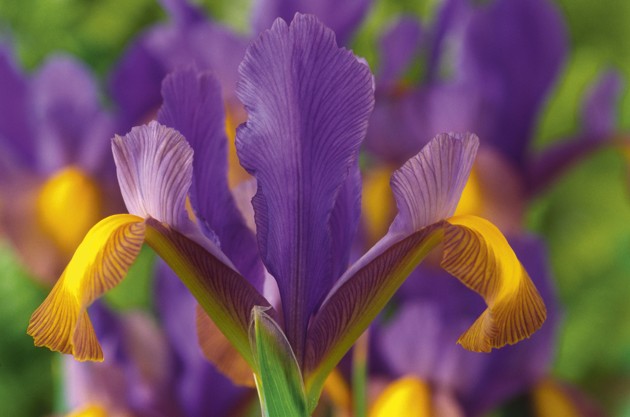While home-grown vegetables are good news, home-grown flowers are magic. Follow our guide on how to grow flowers to cut for arrangements
Flowers have the power to transform a house. But a vase filled with homegrown blooms is even better. Follow our guide on how to grow flowers to cut for arrangements. This doesn’t need to be difficult or expensive – it just requires some advance planning.
Browse The Field’s Gardens category for even more advice and inspiration, from what to add to the vegetable bed to foraging tips and how to encourage more flora and fauna into your garden.
HOW TO GROW FLOWERS TO CUT FOR ARRANGEMENTS
A lady who had agreed to have the rooms of her cottage photographed for a magazine was surprised when the photographer turned up with “one little camera and three huge buckets full of flowers. He said they were his secret weapon.”
And so they are. Flowers can transform the feeling in any house, bringing life and colour into every corner whether they are tall lilies in a stately drawing-room or cheery marigolds in a mug on a cottage window-sill. They are even better when they are fresh from your own garden.
Home-grown vegetables are good news. Home-grown flowers are magic. The important thing about this secret weapon is to do a bit of advance thinking so that you have flowers and foliage to pick throughout all four seasons. High-summer flowers are easy and spring bulbs are reliable but you do need to plan for the long gaps in between.
THE IMPORTANCE OF FOLIAGE
The greenery is important because a few flowers will go a long way if they are backed up by interesting foliage. The flower arranger needs background support whether it comes from the huge palm-like leaves of a hardy Fatsia or the rough, grey-green sprays cut from pampas grass. And the evergreens are usually shrubby things that take much longer to establish than the flowers themselves.
Even a fast-growing hedge plant such as the much-reviled Leyland cypress takes a year or two before it can withstand frequent raids for cutting material. Once it is going strong, however, it is shapely in a container and even pleasantly aromatic. Add a branch from one of the laurels in the shrubbery to your slice of cypress, pick a couple of roses any time between May and October, and you have something to put in that Chinese ginger jar in the hall. If you change the water (and the roses) you might have an arrangement you can enjoy for up to 10 days.
The seasonal plan is most successful if you can devote space to a cutting garden. The flowers need a place of their own, preferably sunny and out of the wind, where you can reach them without having to hack your way through a jungle.
A PRODUCTION LINE
Paving stones were the answer for one Hertfordshire gardener, who told me, “Once I realised that the flower patch was a sort of production line, things got better. I laid out the paving in parallel lines, kept the plants well apart, spread lots of Growmore fertiliser and let things grow. It doesn’t look particularly pretty but we get the flowers we want.”
She swears by hybrid musk and shrub roses (Bonica and Ballerina – single cut with the secateurs produces a huge head of blooms for a vase); Alchemilla mollis (lime-green clouds of flowers); Lysimachia punctata (not long-lasting but very easy and every stem combines flowers and back-up leaves); scented wallflowers in spring (Erysimum); early daffodils and tulips (don’t put them in the same vase as it shortens their shelf-life); high-season lilies; late-season dahlias; all-season coppiced eucalyptus; easy biennial Sweet William (lasts for weeks in water). She also raids the pond for water lilies, which are sensational when floated as individual blooms in crystal bowls.
BUY WHOLESALE
There is still time to plant garden lilies in the cutting rows for the upcoming season but with most spring-flowering bulbs it is a case of noting in your diary – about September – that you should be scanning the catalogues and putting in your order. It is worth buying wholesale – for years I have bought my bulbs from Parker’s wholesale division (www.dutchbulbs.co.uk). It is the bargain way to make sure you have plenty of flowers for summer vases and armfuls to give away.
High on my list for next spring will be daffodils. Flashy but frostproof, surprisingly robust in a spring gale, rabbit-proof, sheep-proof and deer-proof, they are beautiful in a vase on a bright, cold day. Related narcissi are often scented, too. Take note this month as new varieties come into bloom, especially the “orchids” with colourful split coronas. They look wonderful in the house although often thought to be outlandish in the open garden.
SOW AND HOE
Meanwhile, there is still time to make a big success of thIS cut-flower season. When you see the first weed seedlings poking up their heads and reminding you to get out the hoe, they are also a reminder to sow a few rows of this season’s hardy annuals. Sunflowers, sweet peas, larkspur and marigolds are the traditional house-brightening flowers of summer.





